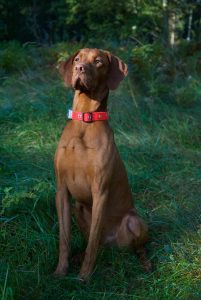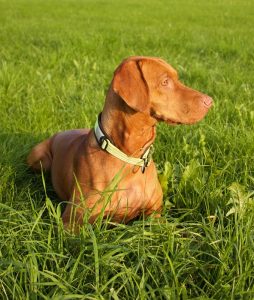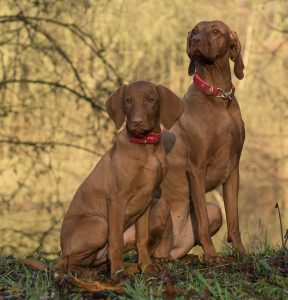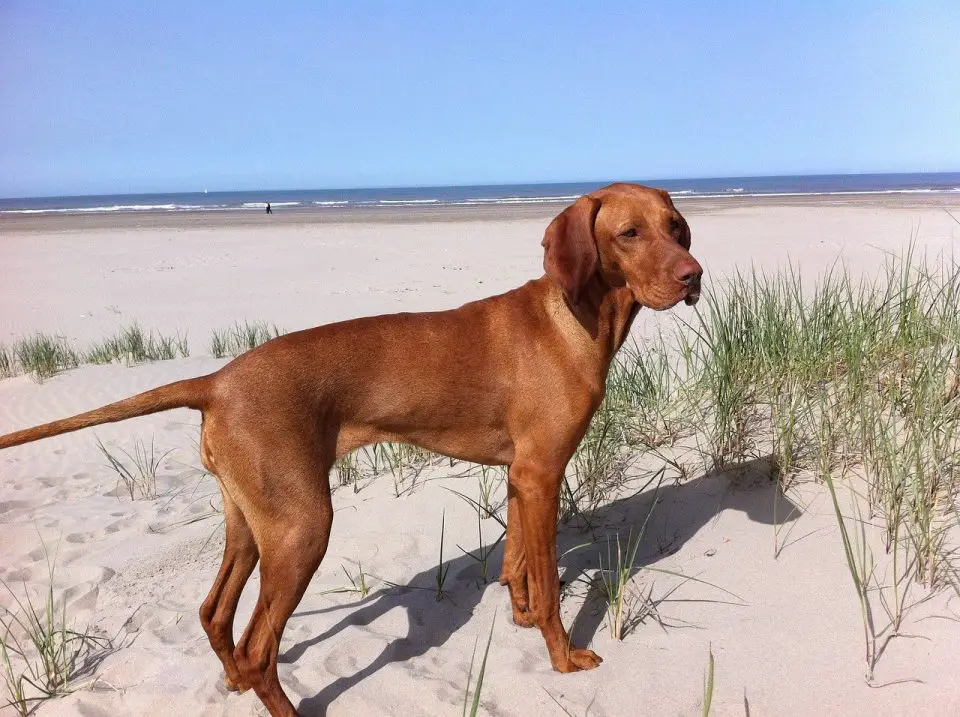A Little About Shedding and Vizslas
The Vizsla was bred in Hungary. It is classified in the FCI Group which is the Pointer group of dogs. There are two types of Vizsla, namely the Hungarian and the Magyar.
Both are sporting types of dogs, and both make excellent companions.
The breed is classed as medium in size and this is possibly one of it’s most appealing traits because it fits in with most families – neither too small nor too large.
The breed is a natural hunting character and you will find that they have exceptional noses. They are incredibly easy to train and will work in either fields and forests or water areas.
While they are gentle-mannered dogs, affectionate and sensitive, they are also fearless and can be very protective.
The short-coated Vizsla appears robust and quite lightly built, they are lean dogs with very defined muscles.
The breed is sometimes confused with others such as the Rhodesian Ridgeback and the Weimaraner as the body is similar in appearance.
Typically, the Vizsla is leaner with more defined muscles and they are smaller than the other two breeds.
One of the features of the Vizsla is the nose which always has a reddish colour. Any dog whose nose is black, brown or light pink is not a true Vizsla and is another breed.
The colours of the Vizslas eyes and nails also blend in with the colour of the coat.
Short History of the Vizsla
We first hear of the Vizsla in an article written in 1357. The dogs were then regarded as companions for warlords and barons.
Land-owning aristocrats who owned the dogs guarded them fiercely and they continued to develop the hunting abilities they still have.
The breed managed to survive not only the Turkish Occupation from 1526-1692, they also got through the Hungarian Revolution in 1848, as well as both world wars.
It was not war that nearly caused them to face extinction but the popularity of English Pointers and German Shorthaired Pointers in the 1800’s.
At one time there were only about a dozen Vizslas left in Hungary. It is from this stock that we find the breed now, doing well and thriving all over the world.
Apart from being bred in Hungary, Vizslas are also bred in Serbia, Slovakia, Austria and Romania.
The first Vizslas arrived in the USA at the end of WWII and people began to take an interest in the new breed.
As a result, the breed gained recognition in the AKC in 1960, becoming the 115th breed to be accepted by the organisation.
What is a Vizslas Coat Like?
 Most Vizslas have a coat in a solid colour. Rust is the most usual colour that you will see a Vizsla sporting.
Most Vizslas have a coat in a solid colour. Rust is the most usual colour that you will see a Vizsla sporting.
It can also be described as russet gold and copper brown. You may even find them in dark sandy gold shades, but they are normally one solid colour.
If you wanted to show your pooch, then coat colours such as dark mahogany red and pale yellow are considered faults and will be disqualified.
Sometimes small white markings are permitted but they are not preferred.
The AKC rules state that the Vizsla coat should be short, smooth, close-lying and dense. There is no woolly undercoat.
For this reason, your Vizsla will not thank you for leaving him outside in cold weather as he has no undercoat to keep him warm.
An interesting fact about the breed is that they are thought of as self-cleaning dogs. They very seldom need to be bathed.
In fact, some owners report that they have never bathed their Vizslas. If the dogs do develop a ‘doggie smell’ a quick bath will get rid of it.
Do Vizslas Shed?
All dogs shed to a certain degree although some shed more than others. Vizslas rate on the average mark for shedding.
They shed what you would class as a ‘normal amount’ so you can expect shed hair on the floor, but not huge amounts.
Because the hair is so short it does not show up so clearly on the floor and furniture, unlike other breeds.
The lighter coloured coat is shed in the spring and the rich, dark colour grows through for the summer months.
How Much do Vizslas Shed?
Vizslas are known as one of the cleanest dogs in the world, and this included the amount of hair they shed.
They shed a normal amount, and this is what you can expect when you imagine a dog in your house.
You will get hair on the brush when you brush them and you will find some hair on the sofa and floor, but nowhere near as much as other breeds like the Retriever or Labrador.
Do, they shed? Yes, they do, but lightly and regularly. There is nothing in a Vizsla to make you think that your house will be covered in hair, because it will not be. A quick sweep daily and it will be hair free.
There is no seasonal shedding like other breeds. Puppies shed very little and adults shed lightly all year round.
So, while you will need to sweep up some hair, it will be far less than other breeds, which is great for anyone who does not like dog hair on the sofa and their clothes.
When do Vizslas Shed the Most
If there is any time that the Vizsla will shed, it is in the spring when he will get rid of the excess hair that has grown over the winter.
The summer coat will come through and you may find some shed hair on the floor.
Vizslas may shed because of medical issues but it will be very obvious to a new owner that there is something wrong as they will not normally shed.
An interesting fact about the Vizsla is that they will often clean themselves like a cat. This is why they are referred to as self-cleaning.
Just as a cat will sit and lick its fur so does the Vizsla. They will use the tongue to lick off the hair.
You will find that the tongue is rough and like sandpaper, similar to that of a cat.
You may wonder if they would cough up fur-balls like a cat, but they seldom do this, because the hair is so short, and can be moved through their digestive system.
If you are wondering what happens to the hair they ingest, it is excreted when your pooch goes to the toilet. Look closely and you will see fine hairs in the poop of any vizsla.
In truth there is really not that much hair that falls off the Vizsla anyway, so not that much to swallow and hardly any on the floors.
How to Combat Vizslas Shedding
 As with many other dogs, you may not be able to combat the hair that they shed, you simply keep it under control.
As with many other dogs, you may not be able to combat the hair that they shed, you simply keep it under control.
Fortunately, the Vizsla is classed as low-maintenance.
A good brushing every few days will keep any dead hair off and keep the house clean.
You should use a soft brush to brush the Vizsla. This way you will remove the lose hair and the coat will stay gleaming and healthy.
You can also remove dead hair by running a damp cloth over the pooch.
There is seldom any need to take a Vizsla to the groomer, they simply do not need to go!
The only part which need attention are the eyebrows and beards, which most people can master and do at home.
Equipment Help to Combat Vizslas Shedding
You need very little grooming equipment for a Vizsla. Apart from nail clippers to keep the nails short, all you will need is a relatively soft brush.
The only other item you should add to the grooming basket is a good-quality doggie shampoo.
Don’t be tempted to use your own on your pooch as this may irritate the skin and even cause an infection.
Are Vizslas Considered to be Hypoallergenic?
No dogs are ever truly hypoallergenic and if a breeder insists that his dogs are, then you may want to look elsewhere.
All dogs shed to some degree, although there are some that shed far less than others. The Vizsla is one of them.
The Vizsla will shed such a small amount that it may be days before you even notice hair on the floor. This makes then an ideal pet for people with allergies.
Do Some Vizslas Shed More Than Others?
No, all Vizslas shed about the same – a normal amount. Even the pups shed about the same amount, so you will never bring a pup home and get a shock when it starts to shed.
Because of the breed there are no variations in the fur. All the pups will shed the same and all the adult Vizslas will shed the same.
The only reason for any more shedding than you would class as normal is if the dog is unwell.
If you do notice that your pooch sheds more than normal or develops bald patches you should take him to the vet as soon as possible as this is not normal for a Vizsla and something is wrong.
Health Reasons for Increased Shedding in Vizslas
Diet is an important part in the Vizslas life and if he is fed a poor-quality diet, he may shed more than normal.
Fortunately, there are many good quality foods available which will supply all the nutrients the Vizsla needs.
With a good quality dog food and a few healthy treats you should be able to get all the necessary fatty acids into their diet. Omega 3 and Omega 6 are vital if you are to keep the coat in good condition.
Giving your pooch the occasional egg will also keep his coat in tip-top condition. Even a raw egg will be fine for the dog as most dogs in the wild eat raw eggs anyway.
Leaving the egg raw also means that they get extra nutrition as cooking destroys some nutrients.
A diet that is rich in fish will also keep the coat in good condition.
If you are unsure about his food, then speak to your vet. They will be able to advise you on the best diet for your pooch.
Pregnancy and feeding may leave your female Vizsla shedding a little more, but as soon as she has stopped feeding her litter, her coat will return to normal.
Apart from internal and external parasites, which will leave the hair and skin irritated, there are very few conditions why a Vizsla will shed.
Any increase in scratching, particularly if it is always in one spot should be checked out as some parasites are too tiny to see right away.
If you notice that your pooch is shedding, then the first place to look is at the diet. More than likely this will be an issue and when sorted the shedding will stop.
Final Thoughts: Do Vizslas Shed?
 Because the breed was originally bred for hunting and a nomadic way of life, eating raw meat is often used as a diet for them. They will adapt to it easily.
Because the breed was originally bred for hunting and a nomadic way of life, eating raw meat is often used as a diet for them. They will adapt to it easily.
You may have heard of the breed being called ‘velcro dogs’ and this is because they like to be close to their masters.
They do not enjoy being apart from their human family and will not be happy on their own for long periods of time.
Of course, in the wild if they did not stay close to their masters, they would simply die from cold, so perhaps this has carried down to a dog who enjoys walking really close to his owner.
If you live in a very cold climate you may want to look into getting your pooch a winter coat to wear when you go for walks. This will keep him warmer and he will also look smart!
Of all the adorable traits of the Vizsla, the type of coat may be the reason for getting one of these amazing dogs.
Lack of hair on the floor and on the sofa, minimal grooming because the pooch does it all himself – what’s not to like about this amazing breed!
